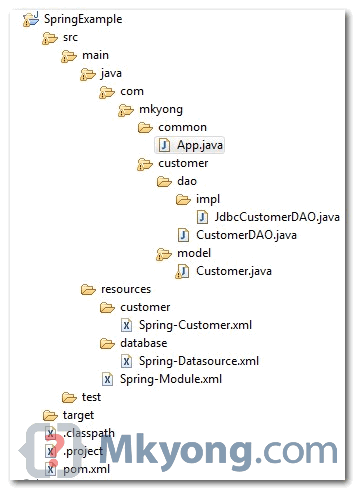Spring + JDBC example
2015-08-23 15:14
471 查看
In this tutorial, we will extend last Maven + Spring hello world example by adding JDBC support, to use Spring + JDBC to insert a record into a
1.
In this example, we are using MySQL database.
File :
3.
Add a
File :
File :
File :

customertable.
1. Customer
table
In this example, we are using MySQL database.CREATE TABLE `customer` ( `CUST_ID` int(10) unsigned NOT NULL AUTO_INCREMENT, `NAME` varchar(100) NOT NULL, `AGE` int(10) unsigned NOT NULL, PRIMARY KEY (`CUST_ID`) ) ENGINE=InnoDB AUTO_INCREMENT=2 DEFAULT CHARSET=utf8;
2. Project Dependency
Add Spring and MySQL dependencies in Mavenpom.xmlfile.
File : pom.xml
<project xmlns="http://maven.apache.org/POM/4.0.0" xmlns:xsi="http://www.w3.org/2001/XMLSchema-instance" xsi:schemaLocation="http://maven.apache.org/POM/4.0.0 http://maven.apache.org/maven-v4_0_0.xsd"> <modelVersion>4.0.0</modelVersion> <groupId>com.mkyong.common</groupId> <artifactId>SpringExample</artifactId> <packaging>jar</packaging> <version>1.0-SNAPSHOT</version> <name>SpringExample</name> <url>http://maven.apache.org</url> <dependencies> <!-- Spring framework --> <dependency> <groupId>org.springframework</groupId> <artifactId>spring</artifactId> <version>2.5.6</version> </dependency> <!-- MySQL database driver --> <dependency> <groupId>mysql</groupId> <artifactId>mysql-connector-java</artifactId> <version>5.1.9</version> </dependency> </dependencies> </project>
3. Customer
model
Add a customermodel to store
customer’s data.
package com.mkyong.customer.model;
import java.sql.Timestamp;
public class Customer
{
int custId;
String name;
int age;
//getter and setter methods
}4. Data Access Object (DAO) pattern
CustomerDao interface.
package com.mkyong.customer.dao;
import com.mkyong.customer.model.Customer;
public interface CustomerDAO
{
public void insert(Customer customer);
public Customer findByCustomerId(int custId);
}CustomerDao implementation, use JDBC to issue a simple insert and select statement.
package com.mkyong.customer.dao.impl;
import java.sql.Connection;
import java.sql.PreparedStatement;
import java.sql.ResultSet;
import java.sql.SQLException;
import javax.sql.DataSource;
import com.mkyong.customer.dao.CustomerDAO;
import com.mkyong.customer.model.Customer;
public class JdbcCustomerDAO implements CustomerDAO
{
private DataSource dataSource;
public void setDataSource(DataSource dataSource) {
this.dataSource = dataSource;
}
public void insert(Customer customer){
String sql = "INSERT INTO CUSTOMER " +
"(CUST_ID, NAME, AGE) VALUES (?, ?, ?)";
Connection conn = null;
try {
conn = dataSource.getConnection();
PreparedStatement ps = conn.prepareStatement(sql);
ps.setInt(1, customer.getCustId());
ps.setString(2, customer.getName());
ps.setInt(3, customer.getAge());
ps.executeUpdate();
ps.close();
} catch (SQLException e) {
throw new RuntimeException(e);
} finally {
if (conn != null) {
try {
conn.close();
} catch (SQLException e) {}
}
}
}
public Customer findByCustomerId(int custId){
String sql = "SELECT * FROM CUSTOMER WHERE CUST_ID = ?";
Connection conn = null;
try {
conn = dataSource.getConnection();
PreparedStatement ps = conn.prepareStatement(sql);
ps.setInt(1, custId);
Customer customer = null;
ResultSet rs = ps.executeQuery();
if (rs.next()) {
customer = new Customer(
rs.getInt("CUST_ID"),
rs.getString("NAME"),
rs.getInt("Age")
);
}
rs.close();
ps.close();
return customer;
} catch (SQLException e) {
throw new RuntimeException(e);
} finally {
if (conn != null) {
try {
conn.close();
} catch (SQLException e) {}
}
}
}
}5. Spring bean configuration
Create the Spring bean configuration file forcustomerDAOand
datasource.
File : Spring-Customer.xml
<beans xmlns="http://www.springframework.org/schema/beans" xmlns:xsi="http://www.w3.org/2001/XMLSchema-instance" xsi:schemaLocation="http://www.springframework.org/schema/beans http://www.springframework.org/schema/beans/spring-beans-2.5.xsd"> <bean id="customerDAO" class="com.mkyong.customer.dao.impl.JdbcCustomerDAO"> <property name="dataSource" ref="dataSource" /> </bean> </beans>
File : Spring-Datasource.xml
<beans xmlns="http://www.springframework.org/schema/beans" xmlns:xsi="http://www.w3.org/2001/XMLSchema-instance" xsi:schemaLocation="http://www.springframework.org/schema/beans http://www.springframework.org/schema/beans/spring-beans-2.5.xsd"> <bean id="dataSource" class="org.springframework.jdbc.datasource.DriverManagerDataSource"> <property name="driverClassName" value="com.mysql.jdbc.Driver" /> <property name="url" value="jdbc:mysql://localhost:3306/mkyongjava" /> <property name="username" value="root" /> <property name="password" value="password" /> </bean> </beans>
File : Spring-Module.xml
<beans xmlns="http://www.springframework.org/schema/beans" xmlns:xsi="http://www.w3.org/2001/XMLSchema-instance" xsi:schemaLocation="http://www.springframework.org/schema/beans http://www.springframework.org/schema/beans/spring-beans-2.5.xsd"> <import resource="database/Spring-Datasource.xml" /> <import resource="customer/Spring-Customer.xml" /> </beans>
6. Review project structure

7. Run it
package com.mkyong.common;
import org.springframework.context.ApplicationContext;
import org.springframework.context.support.ClassPathXmlApplicationContext;
import com.mkyong.customer.dao.CustomerDAO;
import com.mkyong.customer.model.Customer;
public class App
{
public static void main( String[] args )
{
ApplicationContext context =
new ClassPathXmlApplicationContext("Spring-Module.xml");
CustomerDAO customerDAO = (CustomerDAO) context.getBean("customerDAO");
Customer customer = new Customer(1, "mkyong",28);
customerDAO.insert(customer);
Customer customer1 = customerDAO.findByCustomerId(1);
System.out.println(customer1);
}
}output
Customer [age=28, custId=1, name=mkyong]
相关文章推荐
- jdbc中的Statement和PreparedStatement接口对象
- maven学习
- 一个jar包里的网站
- 一个jar包里的网站之文件上传
- 一个jar包里的网站之返回对媒体类型
- maven插件maven-war-plugin的使用
- maven使用经验集
- JDBC 数据库常用连接 链接字符串
- JDBC连接Access数据库的几种方式介绍
- spring+html5实现安全传输随机数字密码键盘
- Spring中属性注入详解
- struts2 spring整合fieldError问题
- spring的jdbctemplate的crud的基类dao
- JDBC 程序的常见错误及调试方法
- 读取spring配置文件的方法(spring读取资源文件)
- java实现简单美女拼图游戏
- Java中使用JDBC操作数据库简单实例
- Java加载JDBC驱动程序实例详解
- java基本教程之线程休眠 java多线程教程
- JSP开发中在spring mvc项目中实现登录账号单浏览器登录
